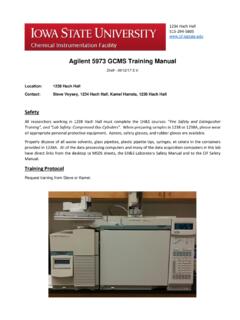Transcription of A basic guide to particle characterization
1 WHITEPAPERM alvern Instruments WorldwideSales and service centres in over 65 2015 Malvern Instruments LimitedA basic guide to particle characterizationPARTICLE SIZEPARTICLE SHAPEI ntroductionThe aim of this guide is to provide you with a basic grounding in the mainparticle characterization techniques currently in use within industry andacademia. It assumes no prior knowledge of particle characterization theory orinstrumentation and should be ideal for those new to particle characterization ,or those wishing to reinforce their knowledge in the area. The guide coversintroductory basics, particle characterization theory and particle characterizationinstrumentation, as well as a quick reference guide to help you decide whichtechniques might be most appropriate for your particle characterization is a particle ?
2 At the most basic level, we can define a particle as being a discrete sub-portionof a substance. For the purposes of this guide , we shall narrow the definition toinclude solid particles, liquid droplets or gas bubbles with physical dimensionsranging from sub-nanometer to several millimeters in most common types of materials consisting of particles are: powders and granules pigments, cement, pharmaceutical ingredients suspensions, emulsions and slurries vaccines, milk, mining muds aerosols and sprays asthma inhalers, crop protection measure particle properties?There are two main reasons why many industries routinely employ particlecharacterization within their Better control of product qualityIn an increasingly competitive global economy, better control of product qualitydelivers real economic benefits such as: ability to charge a higher premium for your product reduce customer rejection rates and lost orders demonstrate compliance in regulated basic guide to particle characterization2.
3 Better understanding of products, ingredients andprocessesIn addition to controlling product quality, a better understanding of how particleproperties affect your products, ingredients and processes will allow you to: improve product performance troubleshoot manufacturing and supply issues optimize the efficiency of manufacturing processes increase output or improve yield stay ahead of the particle properties are important to measure?In addition to chemical composition, the behavior of particulate materials is oftendominated by the physical properties of the constituent particles. These caninfluence a wide range of material properties including, for example, reactionand dissolution rates, how easily ingredients flow and mix, or compressibility andabrasivity. From a manufacturing and development perspective, some of the mostimportant physical properties to measure are: particle size particle shape surface properties mechanical properties charge properties upon the material of interest, some or all of these could be importantand they may even be interrelated: surface area and particle size.
4 For thepurposes of this guide , we will concentrate on two of the most significant andeasy to measure properties - particle size and particle PropertiesParticle sizeBy far the most important physical property of particulate samples is particlesize. particle size measurement is routinely carried out across a wide range ofindustries and is often a critical parameter in the manufacture of many size has a direct influence on material properties such as: reactivity or dissolution rate catalysts, tablets stability in suspension sediments, paints efficacy of delivery asthma inhalers texture and feel food ingredients appearance powder coatings and inks flowability and handling granules viscosity nasal sprays packing density and porosity particle size and understanding how it affects your products andprocesses can be critical to the success of many manufacturing do we define particle size?
5 WHITEPAPER3A basic guide to particle characterizationParticles are 3-dimensional objects, and unless they are perfect spheres ( or bubbles), they cannot be fully described by a single dimension suchas a radius or order to simplify the measurement process, it is often convenient to define theparticle size using the concept of equivalent spheres. In this case the particle sizeis defined by the diameter of an equivalent sphere having the same property asthe actual particle such as volume or mass for example. It is important to realizethat different measurement techniques use different equivalent sphere modelsand therefore will not necessarily give exactly the same result for the 1: Illustration of the concept of equivalent equivalent sphere concept works very well for regular shaped , it may not always be appropriate for irregular shaped particles, such asneedles or plates, where the size in at least one dimension can differ significantlyfrom that of the other 2: Illustration of the volume equivalent rod and sphere of a needle shaped the case of the rod shaped particle shown in the image above, a volumeequivalent sphere would give a particle diameter of 198 m, which is not a veryaccurate description of its true dimensions.
6 However, we can also define theWHITEPAPER4A basic guide to particle characterizationparticle as a cylinder with the same volume which has a length of 360 m and awidth of 120 m. This approach more accurately describes the size of the particleand may provide a better understanding of the behavior of this particle duringprocessing or handling for particle sizing techniques are based on a simple 1-dimensional sphereequivalent measuring concept, and this is often perfectly adequate for therequired application. measuring particle size in two or more dimensions cansometimes be desirable but can also present some significant measurementand data analysis challenges. Therefore careful consideration is advisable whenchoosing the most appropriate particle sizing technique for your size distributionsUnless the sample you wish to characterize is perfectly mono disperse, everysingle particle has exactly the same dimensions, it will consist of a statisticaldistribution of particles of different sizes.
7 It is common practice to represent thisdistribution in the form of either a frequency distribution curve, or a cumulative(undersize) distribution distributionsA particle size distribution can be represented in different ways with respect tothe weighting of individual particles. The weighting mechanism will depend uponthe measuring principle being weighted distributionsA counting technique such as image analysis will give a number weighteddistribution where each particle is given equal weighting irrespective of its is most often useful where knowing the absolute number of particles isimportant - in foreign particle detection for example - or where high resolution( particle by particle ) is weighted distributionsStatic light scattering techniques such as laser diffraction will give a volumeweighted distribution.
8 Here the contribution of each particle in the distributionrelates to the volume of that particle (equivalent to mass if the density isuniform), the relative contribution will be proportional to (size)3. This is oftenextremely useful from a commercial perspective as the distribution represents thecomposition of the sample in terms of its volume/mass, and therefore its potential$ weighted distributionsDynamic light scattering techniques will give an intensity weighted distribution,where the contribution of each particle in the distribution relates to the intensityof light scattered by the particle . For example, using the Rayleigh approximation,the relative contribution for very small particles will be proportional to (size) comparing particle size data for the same sample measured by differenttechniques, it is important to realize that the types of distribution being measuredand reported can produce very different particle size results.
9 This is clearlyillustrated in the example below, for a sample consisting of equal numbers ofparticles with diameters of 5nm and 50nm. The number weighted distributiongives equal weighting to both types of particles, emphasising the presence ofthe finer 5 nm particles, whereas the intensity weighted distribution has a signalWHITEPAPER5A basic guide to particle characterizationone million times higher for the coarser 50nm particles. The volume weighteddistribution is intermediate between the 3: Example of number, volume and intensity weighted particle size distributions for the is possible to convert particle size data from one type of distribution to another,however this requires certain assumptions about the form of the particle and itsphysical properties. One should not necessarily expect, for example, a volumeweighted particle size distribution measured using image analysis to agreeexactly with a particle size distribution measured by laser statistics"There are three kinds of lies: lies, damned lies, and statistics.
10 "Twain, DisraeliIn order to simplify the interpretation of particle size distribution data, a rangeof statistical parameters can be calculated and reported. The choice of the mostappropriate statistical parameter for any given sample will depend upon how thatdata will be used and what it will be compared with. For example, if you wanted toreport the most common particle size in your sample you could choose betweenthe following parameters: mean - 'average' size of a population median - size where 50% of the population is below/above mode - size with highest the shape of the particle size distribution is asymmetric, as is often the case inmany samples, you would not expect these three values to be exactly equivalent,as illustrated basic guide to particle characterizationFigure 4: Illustration of the median mode and mean for a particle size are many different means that can be defined depending upon how thedistribution data are collected and analyzed.









